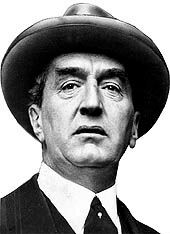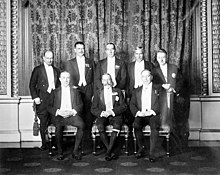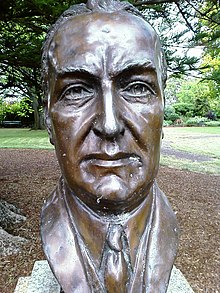Stanley Bruce: Difference between revisions
→Prime Minister: Page not yet a knight |
Tag: repeating characters |
||
| Line 111: | Line 111: | ||
==External links== |
==External links== |
||
{{Commons category|Stanley Bruce}} |
{{Commons category|Stanley Bruce}} |
||
he is awsome in his own way !!! gfjkshxjk |
|||
{{s-start}} |
{{s-start}} |
||
{{s-par|au}} |
{{s-par|au}} |
||
{{s-bef|before=[[William Irvine (Australian politician)|William Irvine]]}} |
{{s-bef|before=[[William Irvine (Australian politician)|William Irvine]]}} |
||
{{s-ttl|title=[[Division of |
{{s-ttl|title=[[Division of Flindgjhgjhers|Member for Flinders]]|years=1918–1929}} |
||
{{s-aft|after=[[Jack Holloway]]}} |
{{s-aft|after=[[Jack Holloway]]}} |
||
{{s-bef|before=[[Jack Holloway]]}} |
{{s-bef|before=[[Jack Holloway]]}} |
||
Revision as of 02:03, 30 August 2012
The Viscount Bruce of Melbourne | |
|---|---|
 | |
| 8th Prime Minister of Australia Elections: 1925, 1928, 1929 | |
| In office 9 February 1923 – 22 October 1929 | |
| Monarch | George V |
| Governors‑General | Lord Forster Lord Stonehaven |
| Preceded by | Billy Hughes |
| Succeeded by | James Scullin |
| Constituency | Flinders (Victoria) |
| Personal details | |
| Born | 15 April 1883 Melbourne, Victoria, Australia |
| Died | 25 August 1967 (aged 84) London, England, United Kingdom |
| Political party | Nationalist (1918–29) United Australia (1931–33) |
| Spouse | Ethel Bruce |
| Alma mater | University of Cambridge |
| Awards | Military Cross 1914-15 Star British War Medal Victory Medal Croix de guerre (France) |
| Military service | |
| Allegiance | |
| Branch/service | British Army |
| Years of service | 1914-unknown |
| Rank | unknown |
| Unit | Royal Fusiliers (deconded 1917) Worcestershire Regiment (Commissioned into) |
| Battles/wars | First World War |
Stanley Melbourne Bruce, 1st Viscount Bruce of Melbourne, CH, MC, FRS,[1] PC (15 April 1883 – 25 August 1967), was an Australian politician and diplomat, and the eighth Prime Minister of Australia. He was the second Australian granted an hereditary peerage of the United Kingdom, but the first whose peerage was formally created.[2] He was the first incumbent Prime Minister to lose his seat at an election; the only other being John Howard in 2007.
Early life

Stanley Bruce was born on Grey Street, St Kilda, a Melbourne suburb, in 1883; however, his family moved shortly after to "Wombalano" on Kooyong Road, Toorak (now owned by the Murdoch family). The boy's father, of Scottish descent, was a prominent businessman.
Bruce was educated at Glamorgan (now part of Geelong Grammar School), Melbourne Grammar School, and then at Cambridge University. After graduation he studied law in London and was called to the bar in 1907. He practised law in London, and also managed the London office of his father's importing business.[3] When World War I broke out he joined the British Army, and was commissioned to the Worcestershire Regiment, seconded to the Royal Fusiliers. In 1917 he was severely wounded in France, winning the Military Cross and the Croix de guerre[disambiguation needed].
Political career

Bruce was invalided home to Melbourne, and soon became involved in recruiting campaigns for the Army. His public speaking attracted the attention of the Nationalist Party, and in 1918 he was elected to the House of Representatives as MP for Flinders, near Melbourne. His background in business led to his being appointed Treasurer (finance minister) in 1921.
The Nationalist Party lost its majority at the 1922 election, and could only stay in office with the support of the Country Party. However, the Country Party let it be known it would not serve under incumbent Prime Minister Billy Hughes. This gave the more conservative members of the Nationalist Party an excuse to force Hughes to resign; the conservatives had only tolerated Hughes in order to keep the Australian Labor Party out of power. Bruce was chosen as Hughes's successor.
Prime Minister

Bruce then entered negotiations with the Country Party leader, Earle Page, for a coalition government. On 9 February 1923 he became prime minister at the age of only 39, at the head (despite being the youngest member) of a Nationalist-Country coalition government. He had to pay a high price in the process, though; he was forced to give the Country Party five posts in a Cabinet of only eleven members. He also had to give Page the Treasury portfolio, as well as the number-two position in the government. These demands were unheard of for such a young party in the Westminster system. Nonetheless, Bruce readily agreed, if only to avoid forcing another election.
Bruce's appointment marked an important turning point in Australian political history. He was the first Prime Minister who had not been involved in the movement for federation, who had not been a member of a colonial Parliament, and who had not been a member of the original 1901 federal Parliament. He was, in addition, the first Prime Minister to head a cabinet consisting entirely of Australian-born ministers.[4] With his aristocratic manners and dress – he drove a Rolls Royce and wore white spats – he was also the first genuinely "Tory" Australian Prime Minister.
In general Bruce formed an effective partnership with Page, and exploited public fears of Communism and militant trade unions to dominate Australian politics through the 1920s. Despite predictions that Australians would not accept such an aloof leader as Bruce, he won a smashing victory over a demoralised ALP, led by Matthew Charlton, at the 1925 election. Throughout his term of office, he pursued a policy of support for the British Empire, the League of Nations, and the White Australia Policy:
"We intend to keep this country white and not allow its peoples to be faced with the problems that at present are practically insoluble in many parts of the world."[5]
In his policy launch speech made at the Shire Hall in Dandenong, south-eastern Melbourne, on 25 October 1925, Bruce reiterated his government's commitment to the White Australia Policy:
"It is necessary that we should determine what are the ideals towards which every
Australian would desire to strive. I think those ideals might well be stated as being to secure our national safety, and to ensure the maintenance of our White Australia Policy to continue as an integral portion of the British Empire."
On 8 July 1928 he was appointed a Companion of Honour.[7] His government was reelected, though with a significantly reduced majority, in 1928.
Maritime Industries crisis

Strikes of sugar mill workers in 1927, waterside workers in 1928, then of transport workers, timber industry workers and coal miners erupted in riots and lockouts in New South Wales in 1929. Bruce responded with a Maritime Industries Bill that was designed to do away with the Commonwealth Court of Conciliation and Arbitration and return arbitration powers to the States.
On 10 September 1929, Hughes and five other Nationalist members joined Labor in voting against the Bill. The Bill was lost by 34 votes to 35 when Littleton Groom, the Speaker, abstained, bringing down the Bruce–Page government and forcing the 1929 election.
Labor, now led by James Scullin (Charlton had resigned from the party's leadership in 1928), won a landslide victory, scoring an 18-seat swing—at the time, the second-worst defeat of a sitting government in Australian history. Bruce was defeated by Labor's candidate Jack Holloway in his electorate of Flinders. Bruce had gone into the election holding Flinders with what appeared to be a fairly safe 10.7 percent two-party majority. However, on the second count an independent Liberal candidate's preferences flowed mostly to Holloway, thus making Bruce the first sitting prime minister to lose his seat. The only other sitting Australian prime minister to be defeated in his own electorate is John Howard, at the 2007 election.
Later life
After his 1929 electoral defeat, Bruce went to England for personal business reasons and contested the 1931 election from that country as a member of the United Australia Party (a merger of Bruce's Nationalists and Labor dissidents). He won his seat back, becoming the first person (and, to date, the only person) ever to be re-elected to parliament after serving as Prime Minister and leaving the House of Representatives.
He was named a Minister without portfolio in the government of Joseph Lyons. Lyons quickly dispatched Bruce back to England to represent the government there and he led the Australian delegation to the 1932 Ottawa Imperial Conference. In 1933 Bruce resigned from Parliament in order to take the position in London as Australian High Commissioner to the United Kingdom. He held this post with great distinction for 12 years, playing a notable role in the Abdication Crisis triggered by Edward VIII, and representing Australia's interests in London during World War II. He was appointed a member of the Imperial War Cabinet and the Pacific War Cabinet.
In 1947 he became the first Australian created an hereditary peer when he was made Viscount Bruce of Melbourne, of Westminster Gardens in the City of Westminster (Sir John Forrest was to have been similarly honoured in 1918, and his peerage was even publicly announced, but he died before it was officially created.)[2][8] He was the first Australian to take his seat in the House of Lords.
Bruce divided the rest of his life between London and Melbourne. He remained Australian High Commissioner until 1945; subsequently he represented Australia on various UN bodies, and his name was considered for the position of United Nations Secretary-General. He was the chairman of the World Food Council for five years. Bruce was appointed as the first Chancellor of the Australian National University and served from 1951 until 1961. The residential college, Bruce Hall at the Australian National University in Canberra was named in honour of Lord Bruce.

Personal
Bruce married Ethel Dunlop Anderson (born 25 May 1879) in 1913.[9] They had no children. He died in London on 25 August 1967, aged 84. As he was childless the viscountcy became extinct. He was cremated and his ashes were scattered on Canberra's Lake Burley Griffin.[4] Viscountess Bruce of Melbourne died on 16 March 1967, only a few months before her husband.[10]
Posthumous honours
In 1972 Bruce was honoured on a postage stamp bearing his portrait issued by Australia Post.[11] The Canberra suburb of Bruce, and the electoral Division of Bruce based in south-east Melbourne, are both named after Stanley Bruce.
Melbourne Grammar School also has a house named after him, Bruce House. Bruce Hall, at the Australian National University, is also named in his honour.
See also
References
- ^ a b Attention: This template ({{cite doi}}) is deprecated. To cite the publication identified by doi:10.1098/rsbm.1970.0004, please use {{cite journal}} (if it was published in a bona fide academic journal, otherwise {{cite report}} with
|doi=10.1098/rsbm.1970.0004instead. - ^ a b Bruce of Melbourne: Man of Two Worlds – C Edwards, 1965
- ^ Radi, Heather (1979). "Bruce, Stanley Melbourne [Viscount Bruce] (1883–1967)". Australian Dictionary of Biography. Canberra: National Centre of Biography, Australian National University. ISBN 978-0-522-84459-7. ISSN 1833-7538. OCLC 70677943. Retrieved 16 February 2010.
- ^ a b Crase, Simon (1 May 2008). "ABC Ballarat". Abc.net.au. Retrieved 4 November 2011.
- ^ Bowen, James (2002). The Great Barrier Reef: History, Science, Heritage. Cambridge University Press. p. 301. ISBN 0-521-82430-3. Retrieved 24 January 2008.
{{cite book}}: Unknown parameter|coauthors=ignored (|author=suggested) (help) - ^ "Policy Launch Speech: Stanley Bruce, Prime Minister" (PDF). The Age. 26 October 1925. p. 11. Archived from the original (PDF) on 2006. Retrieved 24 January 2008.
{{cite web}}: Check date values in:|archivedate=(help); Italic or bold markup not allowed in:|publisher=(help) - ^ "It's an Honour". Itsanhonour.gov.au. 8 July 1928. Retrieved 4 November 2011.
- ^ "No. 37911". The London Gazette. 21 March 1947.
- ^ "Stanley Melbourne Bruce, Before office". Australia's Prime Ministers. National Archives of Australia. Retrieved 16 February 2010.
- ^ "Stanley Melbourne Bruce, Death". Australia's Prime Ministers. National Archives of Australia. Retrieved 16 February 2010.
- ^ "Australian postage stamp". Australian Stamp and Coin Company. Retrieved 16 February 2010.
Further reading
- "Stanley Bruce". National Museum of Australia. Retrieved 16 February 2010.
- Commonwealth Members of Parliament who have served in war, Parliament of Australia, 26 March 2007.
- Carroll, Brian (2004), Australia's Prime Ministers: from Barton to Howard, Rosenburg Press.
- Edwards, Cecil (1965), Bruce of Melbourne: Man of Two Worlds, Heinemann.
- Hughes, Colin A. (1976), Mr Prime Minister. Australian Prime Ministers 1901–1972, Oxford University Press, Melbourne, Victoria, Ch.9. ISBN 0-19-550471-2
External links
he is awsome in his own way !!! gfjkshxjk
- Use dmy dates from April 2012
- Articles with links needing disambiguation from February 2012
- 1883 births
- 1967 deaths
- Alumni of Trinity College, Cambridge
- Australian peers
- Australian people of Scottish descent
- British Army personnel of World War I
- Fellows of the Royal Society
- People educated at Melbourne Grammar School
- Members of the Australian House of Representatives for Flinders
- Members of the Australian House of Representatives
- Members of the Cabinet of Australia
- Members of the Order of the Companions of Honour
- Recipients of the Military Cross
- Recipients of the Croix de Guerre (France)
- Members of the Privy Council of the United Kingdom
- Nationalist Party of Australia politicians
- People educated at Geelong Grammar School
- Politicians from Melbourne
- Prime Ministers of Australia
- Stewards of Henley Royal Regatta
- Treasurers of Australia
- United Australia Party politicians
- Worcestershire Regiment officers
- High Commissioners of Australia to the United Kingdom
